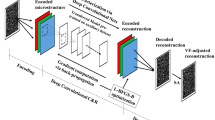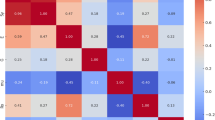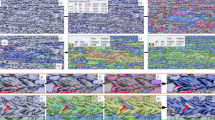Abstract
Predicting the physical property of a class of microstructures is crucial in material design, structural simulation, and design. Property prediction may be conducted millions of times in these studies and is better derived instantly for computational efficiency. This issue is addressed in this study via building a mapping from a 3D microstructure to its effective material property, or called structure–property mapping, using a 3D convolutional neural network (CNN). Unlike the direct approach using labeled simulation data, the mapping is based on the physical knowledge of the structure–property relationship determined by its underlying PDE equations. The knowledge is embedded in the loss function of the CNN framework, which is designed and tested under several different formulations to improve its training convergence. Ultimately, the derived structure–property mapping can instantly predict the associated material property for a given microstructure and has far better generalization ability than the data-labeled approach, as demonstrated via numerical examples.



















Similar content being viewed by others
Data availability
Data will be available upon request.
References
Sun, B., Yan, X., Liu, P., Xia, Y., Lu, L.: Parametric plate lattices: modeling and optimization of plate lattices with superior mechanical properties. Addit. Manufact. 72, 103626 (2023)
Zhao, D., Gu, T.T., Liu, Y., Gao, S., Li, M.: Constructing self-supporting structures in biscale topology optimization. Vis. Comput. 38(3), 1065–1082 (2022)
Xu, H., Liu, R., Choudhary, A., Chen, W.: A machine learning-based design representation method for designing heterogeneous microstructures. J. Mech. Design 137(5), 051403 (2015)
Golovin, I.S., Sinning, H.R.: Damping in some cellular metallic materials. J. Alloy. Compd. 355(1), 2–9 (2003)
Garmestani, H., Lin, S., Adams, B., Ahzi, S.: Statistical continuum theory for large plastic deformation of polycrystalline materials. J. Mech. Phys. Solids 49(3), 589–607 (2001)
Raissi, M., Perdikaris, P., Karniadakis, G.E.: Physics-informed neural networks: a deep learning framework for solving forward and inverse problems involving nonlinear partial differential equations. J. Comput. Phys. 378, 686–707 (2019)
Liu, Y., Greene, M.S., Chen, W., Dikin, D.A., Liu, W.K.: Computational microstructure characterization and reconstruction for stochastic multiscale material design. Comput. Aided Des. 45(1), 65–76 (2013)
Yang, Z., Yabansu, Y.C., Al-Bahrani, R., Liao, W.-K., Choudhary, A.N., Kalidindi, S.R., Agrawal, A.: Deep learning approaches for mining structure-property linkages in high contrast composites from simulation datasets. Comput. Mater. Sci. 151, 278–287 (2018)
Cecen, A., Dai, H., Yabansu, Y.C., Kalidindi, S.R., Song, L.: Material structure-property linkages using three-dimensional convolutional neural networks. Acta Mater. 146, 76–84 (2018)
Chen, D., Levin, D.I., Sueda, S., Matusik, W.: Data-driven finite elements for geometry and material design. ACM Trans. Graph. (TOG) 34(4), 1–10 (2015)
Tan, S., Wong, T., Zhao, Y., Chen, W.: A constrained finite element method for modeling cloth deformation. Vis. Comput. 15, 90–99 (1999)
Conde-Rodríguez, F., Torres, J.-C., García-Fernández, Á.-L., Feito-Higueruela, F.-R.: A comprehensive framework for modeling heterogeneous objects. Vis. Comput. 33, 17–31 (2017)
Xia, L., Raghavan, B., Breitkopf, P., Zhang, W.: A POD/PGD reduction approach for an efficient parameterization of data-driven material microstructure models. Comput. Methods Mater. Sci. 13(1–3), 219–225 (2013)
Nesme, M., Kry, P.G., Jeřábková, L., Faure F.: Preserving topology and elasticity for embedded deformable models, in: ACM SIGGRAPH 2009 papers, pp. 1–9, (2009)
Kharevych, L., Mullen, P., Owhadi, H., Desbrun, M.: Numerical coarsening of inhomogeneous elastic materials. ACM Trans. Graphics (TOG) 28(3), 1–8 (2009)
Torres, R., Rodríguez, A., Espadero, J.M., Otaduy, M.A.: High-resolution interaction with corotational coarsening models. ACM Trans. Graph. 35(6), 1–11 (2016)
Chen, J., Bao, H., Wang, T., Desbrun, M., Huang, J.: Numerical coarsening using discontinuous shape functions. ACM Trans. Graph. (TOG) 37(4), 1–12 (2018)
Fang, Z., Starly, B., Sun, W.: Computer-aided characterization for effective mechanical properties of porous tissue scaffolds. Comput. Aided Des. 37(1), 65–72 (2005)
Kröner E.: Statistical modelling, in: Modelling small deformations of polycrystals, Springer, pp. 229–291, (1986)
Torquato, S., Haslach, H., Jr.: Random heterogeneous materials: microstructure and macroscopic properties. Appl. Mech. Rev. 55(4), B62–B63 (2002)
Michel, J.-C., Moulinec, H., Suquet, P.: Effective properties of composite materials with periodic microstructure: a computational approach. Comput. Methods Appl. Mech. Eng. 172(1–4), 109–143 (1999)
Liu, X., Shapiro, V.: Homogenization of material properties in additively manufactured structures. Comput. Aided Des. 78, 71–82 (2016)
White, D.A., Arrighi, W.J., Kudo, J., Watts, S.E.: Multiscale topology optimization using neural network surrogate models. Comput. Methods Appl. Mech. Eng. 346, 1118–1135 (2019)
Groen, J.P., Wu, J., Sigmund, O.: Homogenization-based stiffness optimization and projection of 2D coated structures with orthotropic infill. Comput. Methods Appl. Mech. Eng. 349, 722–742 (2019)
Bessa, M., Bostanabad, R., Liu, Z., Hu, A., Apley, D.W., Brinson, C., Chen, W., Liu, W.K.: A framework for data-driven analysis of materials under uncertainty: countering the curse of dimensionality. Comput. Methods Appl. Mech. Eng. 320, 633–667 (2017)
Liu, Z., Fleming, M., Liu, W.K.: Microstructural material database for self-consistent clustering analysis of elastoplastic strain softening materials. Comput. Methods Appl. Mech. Eng. 330, 547–577 (2018)
Xia, L., Breitkopf, P.: Multiscale structural topology optimization with an approximate constitutive model for local material microstructure. Comput. Methods Appl. Mech. Eng. 286, 147–167 (2015)
Zhu, L., Li, M., Xu, W.: Direct design to stress mapping for cellular structures. Visual Inf. 3(2), 69–80 (2019)
Groen, J.P., Sigmund, O.: Homogenization-based topology optimization for high-resolution manufacturable microstructures: homogenization-based topology optimization for high-resolution manufacturable microstructures. Int. J. Numer. Meth. Eng. 113(8), 1148–1163 (2018)
Wu, J., Wang, W., Gao, X.: Design and optimization of conforming lattice structures. IEEE Trans. Visual Comput. Graph. 27(1), 43–56 (2019)
Holdstein, Y., Fischer, A.: Three-dimensional surface reconstruction using meshing growing neural gas (MGNG). Vis. Comput. 24, 295–302 (2008)
Lefik, M., Boso, D.P., Schrefler, B.A.: Artificial neural networks in numerical modelling of composites. Comput. Methods Appl. Mech. Eng. 198(21), 1785–1804 (2009)
Le, B.A., Yvonnet, J., He, Q.-C.: Computational homogenization of nonlinear elastic materials using neural networks: neural networks-based computational homogenization. Int. J. Numer. Meth. Eng. 104(12), 1061–1084 (2015)
Liu, Z., Wu, C., Koishi, M.: A deep material network for multiscale topology learning and accelerated nonlinear modeling of heterogeneous materials. Comput. Methods Appl. Mech. Eng. 345, 1138–1168 (2019)
Yang, X., Li, M., Zhu, L., Zhong, W.: Evolutionary discrete multi-material topology optimization using CNN-based simulation without labeled training data, in: International Design Engineering Technical Conferences and Computers and Information in Engineering Conference, Vol. 85376, American Society of Mechanical Engineers, p. V002T02A027, (2021)
Peng, H., Liu, A., Huang, J., Cao, L., Liu, J., Lu, L.: Ph-net: parallelepiped microstructure homogenization via 3d convolutional neural networks. Addit. Manufact. 60, 103237 (2022)
Ronneberger O., Fischer, P., Brox, T.: U-net: Convolutional networks for biomedical image segmentation (2015). arXiv:1505.04597
Papanicolau, G., Bensoussan, A., Lions, J.-L.: Asymptotic analysis for periodic structures, vol. 5. Elsevier, UK (1978)
Palencia, E.S.: Non-homogeneous media and vibration theory. Springer-Verlag, USA (1980)
Bendsøe, M.P., Kikuchi, N.: Generating optimal topologies in structural design using a homogenization method. Comput. Methods Appl. Mech. Eng. 71(2), 197–224 (1988)
Beck, C., Becker, S., Grohs, P., Jaafari, N., Jentzen, A.: Solving stochastic differential equations and Kolmogorov equations by means of deep learning, arXiv:1806.00421 (2018)
Berg, J., Nyström, K.: A unified deep artificial neural network approach to partial differential equations in complex geometries. Neurocomputing 317, 28–41 (2018)
Zhu, Y., Zabaras, N., Koutsourelakis, P.-S., Perdikaris, P.: Physics-constrained deep learning for high-dimensional surrogate modeling and uncertainty quantification without labeled data. J. Comput. Phys. 394, 56–81 (2019)
Sigmund, O.: Materials with prescribed constitutive parameters: an inverse homogenization problem. Int. J. Solids Struct. 31(17), 2313–2329 (1994)
Gu, J., Wang, Z., Kuen, J., Ma, L., Shahroudy, A., Shuai, B., Liu, T., Wang, X., Wang, G., Cai, J., et al.: Recent advances in convolutional neural networks. Pattern Recogn. 77, 354–377 (2018)
Garg, R., BG, V.K., Carneiro, G., Reid, I.: Unsupervised CNN for single view depth estimation: geometry to the rescue, in: European Conference on Computer Vision, Springer, 2016, pp. 740–756
Zhang, Y., Chan, W., Jaitly, N.: Very deep convolutional networks for end-to-end speech recognition, in: 2017 IEEE International Conference on Acoustics, Speech and Signal Processing (ICASSP), IEEE, pp. 4845–4849, (2017)
Simonyan, K., Zisserman, A.: Very deep convolutional networks for large-scale image recognition, arXiv preprint arXiv:1409.1556 (2014)
Andreassen, E., Andreasen, C.S.: How to determine composite material properties using numerical homogenization. Comput. Mater. Sci. 83, 488–495 (2014)
Dong, G., Tang, Y., Zhao, Y.F.: A 149 line homogenization code for three-dimensional cellular materials written in MATLAB. J. Eng. Mater. Technol. 141(1), 011005 (2019)
Cheng, L., Zhang, P., Biyikli, E., Bai, J., Pilz, S.: To, A.C. Integration of topology optimization with efficient design of additive manufactured cellular structures, in: Solid Freeform Fabrication Symposium, Austin, TX, pp. 10–12, (2015)
Yoo, D.-J.: Computer-aided porous scaffold design for tissue engineering using triply periodic minimal surfaces. Int. J. Precis. Eng. Manuf. 12(1), 61–71 (2011)
Yang, N., Quan, Z., Zhang, D., Tian, Y.: Multi-morphology transition hybridization CAD design of minimal surface porous structures for use in tissue engineering. Comput. Aided Des. 56, 11–21 (2014)
Dong, L., Gamal, S.H., Atluri, S.N.: Stochastic macro material properties, through direct stochastic modeling of heterogeneous microstructures with randomness of constituent properties and topologies, by using trefftz computational grains (tcg), CMC: Computers. Materials & Continua 37(1), 1–21 (2013)
Smith, L.N.: A disciplined approach to neural network hyper-parameters: part 1–learning rate, batch size, momentum, and weight decay, arXiv preprint arXiv:1803.09820 (2018)
Acknowledgements
We would like to thank all the anonymous reviewers for their valuable comments and suggestions. The work described in this paper is partially supported by the National Key Research and Development Program of China (No. 2020YFC2201303), and the NSF of China (No. 62372401).
Author information
Authors and Affiliations
Corresponding author
Ethics declarations
Conflict of interest
The authors declare no conflict of interest.
Additional information
Publisher's Note
Springer Nature remains neutral with regard to jurisdictional claims in published maps and institutional affiliations.
Rights and permissions
Springer Nature or its licensor (e.g. a society or other partner) holds exclusive rights to this article under a publishing agreement with the author(s) or other rightsholder(s); author self-archiving of the accepted manuscript version of this article is solely governed by the terms of such publishing agreement and applicable law.
About this article
Cite this article
Zhu, L., Wang, X., Zhong, W. et al. Learning microstructure–property mapping via label-free 3D convolutional neural network. Vis Comput (2024). https://doi.org/10.1007/s00371-024-03411-5
Accepted:
Published:
DOI: https://doi.org/10.1007/s00371-024-03411-5




